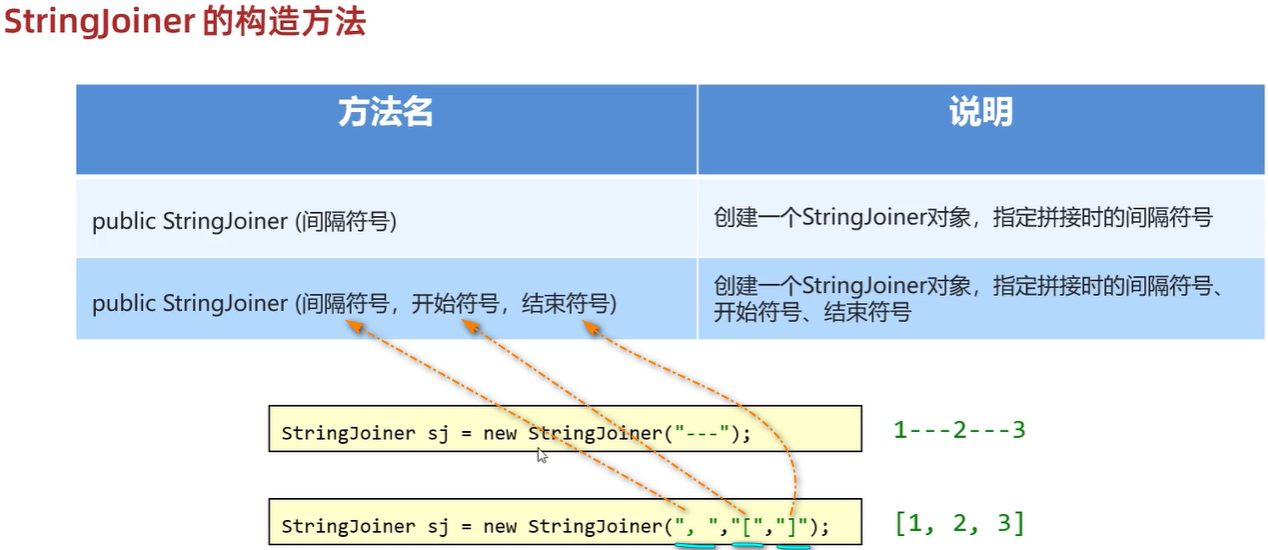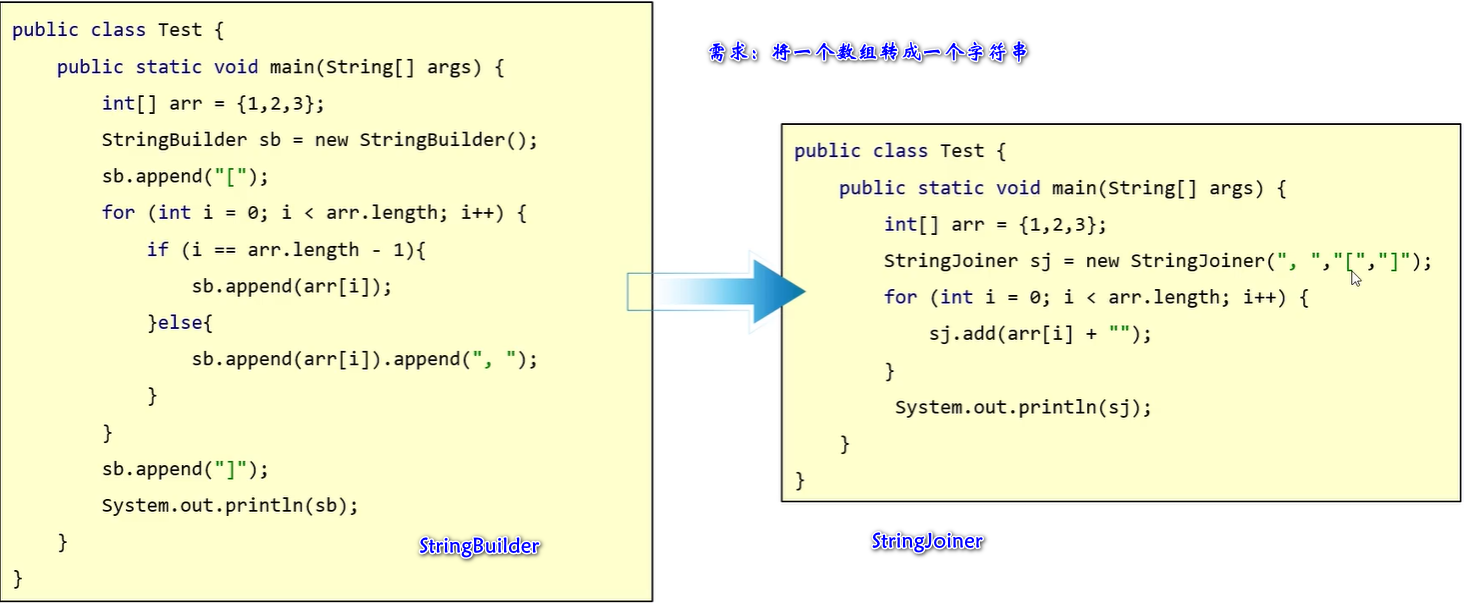1. StringJoiner类

构造方法:(StringJoiner中没有无参构造 )
成员方法:
举个例子,把数组转成字符串:
2. Lambda表达式
练习1:使用Lambda求出整型数组元素之和
interface Operator{public abstract int getSum(int[] arr);}public class OperatorDemo {public static void main(String[] args) {// 这是使用匿名内部类的方式method(new Operator() {@Overridepublic int getSum(int[] arr) {int sum = 0;for(int num : arr) {sum += num;}return sum;}});// 使用Lambda表达式的方式 (IDEA中可以直接把匿名内部类转化为Lambda)method(arr -> {int sum = 0;for(int num : arr) {sum += num;}return sum;});}public static void method(Operator op) {int[] nums = {1,2,3,4,5};int sum = op.getSum(nums);System.out.println(sum);}}
练习2:使用函数式接口返回数组元素的最大值
// Supplier接口,无参有返回值,供给型@FunctionalInterfacepublic interface Supplier<T> {public abstract T get();}public class SupplierDemo {public static void main(String[] args) {// 这是使用匿名内部类的方式printMax(new Supplier() {@Overridepublic Integer get() {int[] arr = {10, 20, 100, 30, 40, 50};Arrays.sort(arr);return arr[arr.length - 1];}});// 这是使用Lambda表达式的方式printMax(() -> {int[] arr = {10, 20, 100, 30, 40, 50};Arrays.sort(arr);return arr[arr.length - 1];});}private static void printMax(Supplier<Integer> supplier) {// 调用接口中的get方法int max = supplier.get();System.out.println("max = " + max);}}
练习3:使用Lambda表达式将一个字符串先转成小写,再转成大写。
// Consumer消费型接口,可以拿到accept方法参数传递过来的数据进行处理, 有参无返回的接口public interface Consumer<T> {public abstract void accept(T t);}public class ConsumerDemo {public static void main(String[] args) {// 匿名内部类实现convert(new Consumer<String>() {@Overridepublic void accept(String s) {System.out.println(s.toLowerCase());}}, new Consumer<String>() {@Overridepublic void accept(String s) {System.out.println(s.toUpperCase());}});// 使用Lambda表达式实现convert(s -> System.out.println(s.toLowerCase()),s -> System.out.println(s.toUpperCase()));}// 先转成全小写,再转成全大写public static void convert(Consumer<String> c1, Consumer<String> c2) {String str = "Hello World";c1.accept(str);c2.accept(str);}}------------------------------------------------------------------------------// 以上convert方法可以简化,可以使用Consumer 接口中的default方法 andThen进行简化// 通过链式写法可以实现更多步骤的组合public static void convert(Consumer<String> c1, Consumer<String> c2) {String str = "Hello World";c1.andThen(c2).accept(str);c2.andThen(c1).accept(str);}
练习4:使用Lambda表达式将字符串转成整型
// Function<T,R> 接口用来根据一个类型的数据得到另一个类型的数据。前者T称为前置条件,后者R称为后置条件。有参数有返回值。@FunctionalInterfacepublic interface Function<T, R> {public abstract R apply(T, t);}public class FunctionDemo {public static void main(String[] args) {// 匿名内部类实现str2num(new Function<String, Integer>() {@Overridepublic Integer apply(String s) {return Integer.parseInt(s);}});// Lambda表达式实现(以下两种都可以)str2num(s -> Integer.parseInt(s));str2num(Integer::parseInt);}private static void str2num(Function<String, Integer> function) {Integer num = function.apply("1511711");System.out.println("res: " + (num + 5));}}
练习5:使用Lambda表达式先将一个字符串转为整型,再乘以10
public class FunctionDemo {public static void main(String[] args) {// 匿名内部类实现test(new Function<String, Integer>() {@Overridepublic Integer apply(String s) {return Integer.parseInt(s);}}, new Function<Integer, Integer>() {@Overridepublic Integer apply(Integer i) {return i * 10;}});// Lambda表达式实现(以下两种都可以)test(s -> Integer.parseInt(s), i -> i * 10);test(Integer::parseInt, i -> i * 10);}private static void test(Function<String, Integer> f1, Function<Integer, Integer> f2) {// 先把字符串转为整型,再乘以10,输出结果Integer num = f1.apply("10086");Integer res = f2.apply(num);System.out.println(res);}---------------------------------------------------------------------------------// Function 接口中有一个默认的 andThen 方法,用来进行组合操作private static void test(Function<String, Integer> f1, Function<Integer, Integer> f2) {Integer res = f1.andThen(f2).apply("10086");System.out.println(res);}}
练习6:使用Lambda判断一个人名如果超过3个字就认为是很长的名字
public class PredicateDemo {public static void main(String[] args) {String name = "迪丽热巴";// 匿名内部类实现judgeName(new Predicate<String>() {@Overridepublic boolean test(String s) {return s.length() > 3;}}, name);// Lambda表达式实现judgeName(s -> s.length() > 3, name);}private static void judgeName(Predicate<String> pre, String name) {boolean isLong = pre.test(name);System.out.println("isLong: " + isLong);}}
练习6:
- 使用Lambda表达式判断一个字符串中即包含H,也包含W;
- 使用Lambda表达式判断一个字符串中包含H或者包含W;
使用Lambda表达式判断一个字符串中不包含W;
public class PredicateDemo {public static void main(String[] args) {judgeAnd(new Predicate<String>() {@Overridepublic boolean test(String s) {return s.contains("H");}}, new Predicate<String>() {@Overridepublic boolean test(String s) {return s.contains("W");}});judgeAnd(s -> s.contains("H"), s -> s.contains("W"));judgeOr(s -> s.contains("H"), s -> s.contains("W"));judgeNegate(s -> s.contains("W"));}private static void judgeAnd(Predicate<String> p1, Predicate<String> p2){String str = "HelloWorld";// 判断包含大写“H”boolean b1 = p1.test(str);// 判断包含大写“W”boolean b2 = p2.test(str);System.out.println(b1 && b2 ? "满足条件" : "不满足");// 也可以这么写boolean b = p1.and(p2).test(str);System.out.println(b ? "and ✔" : "and ❌");}private static void judgeOr(Predicate<String> p1, Predicate<String> p2){String str = "XiaoMi";boolean b = p1.or(p2).test(str);System.out.println(b ? "or ✔" : "or ❌");}private static void judgeNegate(Predicate<String> p1) {String str = "XiaoMi";boolean b = p1.negate().test(str);System.out.println(b ? "negate ✔" : "negate ❌");}}

